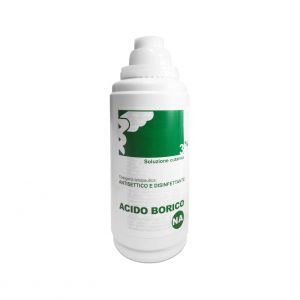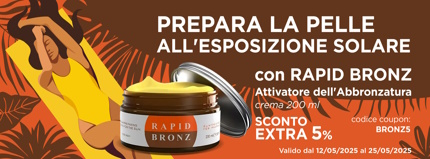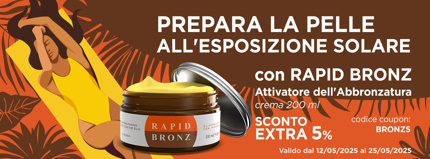Ship in Europe, Find out rates!
Nova Argentia Boric Acid 3% Antiseptic Disinfectant Cutaneous Solution 500 ml

- box Delivery in Italy in 24/48 and free returns
- star3.000+ positive reviews
- dropboxOver 60,000 products in the catalog
Cutaneous solution based on boric acid.
Therapeutic indications
Boric Acid Nova Argentia is used as an antiseptic for the disinfection of minor burns and irritated or chapped skin areas. The solution is also used in the form of local buffers with a decongestant action. Boric acid is indicated as an antibacterial for treating acne.
Dosage and Posology
The drug should be taken according to the following doses and methods.
- Adults
Boric acid can be applied directly once or twice a day to inflamed areas if you have chapped, irritated or dry skin, abrasions, mild burns, sunburns, wind burns, or insect bites.
- Children over 3 years old
Boric acid can be applied directly once or twice a day to inflamed areas associated with chapped, irritated or dry skin, diaper rash, mild sunburn, sunburn, wind burn, or insect bites.
Overdose
The risk of acute cutaneous intoxication appears to be negligible given its low transcutaneous absorption index. Boric acid can be absorbed in toxic quantities through the gastrointestinal tract, by inhalation or through skin lesions.
As a result of the use of large quantities of boric acid on wounds or sores, cases of poisoning and death have occurred, especially in children. The mechanism of the toxic action is unknown and numerous organs and systems are affected, in particular the skin, kidney and digestive tract. The toxic effects also affect the CNS and the lung with lesions, mainly hemorrhagic, of obscure origin. The main symptoms of boric acid poisoning are vomiting, diarrhea, visceral pain, peeling skin rash, CNS stimulation followed by depression, restlessness, headache. Metabolic acidosis and severe water and salt imbalances are also frequent. Furthermore, boric acid in these situations can cause seizures, changes in body temperature and kidney damage which can be evidenced with oliguria. Death from circulatory collapse and untreated shock can occur within 3-5 days. Cyanosis, delirium, seizures and coma (HSDB) can also occur. Cases of severe intoxication have manifested themselves with gastrointestinal disorders (73%), central nervous system (67%) and skin lesions (76%). Symptoms of chronic poisoning include anorexia, confusion, debilitation, dermatitis, menstrual disorders, anemia, seizures, and alopecia.
No treatment is needed if the dose taken is less than 50 mg / kg. For ingestion of higher doses, gastric lavage is performed with activated charcoal suspension and saline purgative. If the absorbed quantity exceeds 100 mg / kg, even if the patient is still asymptomatic, forced diuresis must be instituted immediately, in order to accelerate elimination and protect the kidney from toxic effects; at the first signs of renal insufficiency and water overdose, forced diuresis should be replaced with peritoneal dialysis or hemodialysis. The remaining therapy is symptomatic and resuscitation.
Contraindications
- Hypersensitivity to the active substance or to any of the excipients
- Extensive skin lesions
- Children under 3 years of age.
Side effects
Absorption of boric acid through intact skin is less than 0.5%; however it may increase if accidentally administered systemically or applied to wounds or lesions. The following are the undesirable effects of boric acid that occurred in case of accumulation toxicity, after prolonged exposure and following systemic absorption. These effects are organized according to the MedDRA System Organ Class. Insufficient data are available to establish the frequency of the individual effects listed.
- Skin and subcutaneous tissue disorders: dermatitis, rashes, alopecia.
- Gastrointestinal disorders: gastro-intestinal disorders: nausea, vomiting, diarrhea.
- Metabolism and nutrition disorders: anorexia
- Endocrine disorders: menstrual disorders.
- Blood and lymphatic system disorders: anemia.
- Musculoskeletal and connective tissue disorders; weakness.
- Psychiatric disorders: confusion
- Nervous system disorders: convulsions.
Pregnancy and breastfeeding
No clinical data on exposed pregnancies are available. Animal studies are insufficient to highlight effects on embryonic / fetal development. the potential risk for humans is unknown, however if the medicinal product is used in accordance with the directions for use, the absorption is low and the risk of systemic effects is minimal.
There are no data on the use of the medicine during breastfeeding and it is not known whether this active ingredient passes into breast milk. However, as the absorption of the drug can be considered negligible, it is very unlikely that significant quantities reach the breast milk.
Special warnings
Excessive and prolonged application to large areas or broken skin can cause build-up toxicity. Keep out of reach of children, as deaths have occurred as a result of accidental ingestion. The medicinal product must not be used for ophthalmic use. Nova Argentia boric acid 3% cutaneous solution contains: - sodium benzoate: slightly irritating to skin, eyes and mucous membranes. - parahydroxybenzoates: can cause allergic reactions (possibly delayed). - propylene glycol: can cause skin irritation.
Expiry and retention
Check the expiration date indicated on the package. The expiry date indicated on the package refers to the product in intact packaging, correctly stored. Keep the container tightly closed to protect from light.
Warning : do not use the medicine after the expiry date indicated on the package.
Composition
100 ml of Boric Acid 3% Nova Argentia Cutaneous solution contain:
Active principle
Boric acid 3 g.
Excipients
Purified water.

